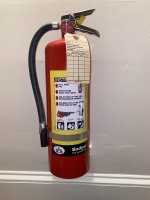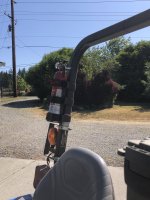You are using an out of date browser. It may not display this or other websites correctly.
You should upgrade or use an alternative browser.
You should upgrade or use an alternative browser.
Show your fire extinguisher
- Thread starter scootr
- Start date
- Views: 15266
More options
Who Replied?
/ Show your fire extinguisher
#41
WinterDeere
Super Star Member
- Joined
- Sep 6, 2011
- Messages
- 12,918
- Location
- Philadelphia
- Tractor
- John Deere 3033R, 855 MFWD, 757 ZTrak; IH Cub Cadet 123
Amazon seems to use an interest-based pricing model. Revisit a single item multiple times from multiple locations, and you'll sometimes see the price increase over a few days. Not enough to really matter, it's usually just a few pennies or percent, but interesting to watch, nonetheless. Don't revisit that item for a few weeks, or check on a seasonal item you had bought previously that is now out of season, and you can sometimes see the reverse effect.Amazon or eBay. Amazon prices can change quite a bit over time.
bigtiller
Super Member
- Joined
- Feb 1, 2006
- Messages
- 7,351
- Location
- central Iowa
- Tractor
- John Deere 2720 John Deere 3039R John Deere Z545R
I got one just like it from my neighbors son, who works for a fire extinguisher repair company.Smokeydog, I sure like the bracket you show - where can I find one like that? I've only seen the flimsy ones that usually come with the extinguisher, and are next to impossible to mount to the tractor. I'd get a couple of those if I could find them! Thanks, Greg
Is there one near you?
mo1
Platinum Member
I had an aquaintenance who was caught in a riot while driving his truck in Potland Oregon...
I see what you did there...
TC 30
New member
hslogger
Platinum Member
I have 2.5 and 5 pound ABC dry chemical units and just recently had a couple of them hydro tested and refilled. I will ad that all of my extinguishers at this time are AMEREX. Not badger not kidde, 'nada. At risk of a ford and chevy contest, Amerex has better guts. I serviced many brands decades ago and believe what I say is true to this day. Previous to then, I ran General'. You will never gripe about what you paid for any unit once you need it.! I buy mine locally and have them serviced the same. If you have a big enough outfit, a local extinguisher company can put you on their list, come out now and then and do an update tag on your extinguishers. You insurance agent loves to see that kind of detail.
WinterDeere
Super Star Member
- Joined
- Sep 6, 2011
- Messages
- 12,918
- Location
- Philadelphia
- Tractor
- John Deere 3033R, 855 MFWD, 757 ZTrak; IH Cub Cadet 123
These two brands make up at least 10 of my dozen-odd extinguishers, as well. Although Badger does also make professional serviceable extinguishers, or at least they did in 1998. Here's the one hanging in my basement stairway:...all of my extinguishers at this time are AMEREX... Previous to then, I ran General'.

notaz3
Gold Member
- Joined
- Feb 17, 2020
- Messages
- 483
- Location
- Here for summer, there in winter.
- Tractor
- 2022 Kubota L3560HSTC
It's very good for fuel/oil fires and can be used with electrical too.Are there any one that knows what PURPLE K is use for?
willy
Leaves a cool (very corrosive) purple powder if used.
Williy
Elite Member
- Joined
- Apr 26, 2020
- Messages
- 3,627
- Location
- Texas
- Tractor
- Yanmar YT 235C Yannar YRC 60 rotary cutter, Yanmar RT72 rotary tiller B75 Backhoe & bucket & thumb, LS land grader
The Navy uses them for chopper crashes magnesium was only able
to extinguish the fires with Purple K as water makes mag burn hotter and faster and if possible would just push the chopper over the side
if possible.
willy
to extinguish the fires with Purple K as water makes mag burn hotter and faster and if possible would just push the chopper over the side
if possible.
willy
scootr
Super Member
- Joined
- Aug 9, 2022
- Messages
- 8,708
- Location
- Temecula California
- Tractor
- Kubota MX5200 HST, 773 Bobcat, Cat forklift
hslogger
Platinum Member
PKP is standard on aircraft carriers along with liquid foam. Nasty stuff that works when it should. Don't leave port with out it.Are there any one that knows what PURPLE K is use for?
willy
tacticalturnip
Super Member
PKP is standard on aircraft carriers along with liquid foam. Nasty stuff that works when it should. Don't leave port with out it.
I used to keep a Purple K in my truck; it left the Army with me, but I don't believe it survived my accident last year.
true temper
Silver Member
Here’s mine 3430 Kubota.

Rvrrat14
Silver Member
- Joined
- May 2, 2013
- Messages
- 101
- Location
- Texas
- Tractor
- Yanmar YM347A Bush Whacker HD72 shredder, Armstrong BGR64-5 grapple, E.L. Caldwell 66” box blade, Advanced Earth 48” pallet forks, 43x45 Safety Basket
Been studying this thread. Some good information.
I’m trying to figure out where to mount. I’m considering mounting a Kidde mount on the right rear fender, which is on the side where the loader stick/hoses are located, so it won’t interfere with mounting/dismounting the tractor seat. I don’t want to mount on ROPS and limit view, nor behind seat as space is limited as I’m long legged.
Has anyone done this? Downside to mounting on fender? thanks!
I’m trying to figure out where to mount. I’m considering mounting a Kidde mount on the right rear fender, which is on the side where the loader stick/hoses are located, so it won’t interfere with mounting/dismounting the tractor seat. I don’t want to mount on ROPS and limit view, nor behind seat as space is limited as I’m long legged.
Has anyone done this? Downside to mounting on fender? thanks!
gstrom99
Elite Member
- Joined
- Nov 4, 2015
- Messages
- 2,624
- Location
- Greene, Iowa
- Tractor
- Deere 855, Deere 530R zero turn, Allis Chalmers D17 III, Polaris Ranger, Deere 3032E (SIL's), Yamaha Timberwolf 250, Husky saws, H & H 10k and Carry-On trailers
No pic handy, but I hose clamped the mounts for a marine type extinguisher to my ROPS nice and low. No vibration.
scootr
Super Member
- Joined
- Aug 9, 2022
- Messages
- 8,708
- Location
- Temecula California
- Tractor
- Kubota MX5200 HST, 773 Bobcat, Cat forklift
Rvrrat14
Silver Member
- Joined
- May 2, 2013
- Messages
- 101
- Location
- Texas
- Tractor
- Yanmar YM347A Bush Whacker HD72 shredder, Armstrong BGR64-5 grapple, E.L. Caldwell 66” box blade, Advanced Earth 48” pallet forks, 43x45 Safety Basket
I have looked at my tractor closer and believe I can use a 1lb ABC and some 3” pvc to mount behind my seat. Section out the pvc and simply drop the canister into it. Simple.
Here are some similar links:
- Replies
- 2
- Views
- 1K





